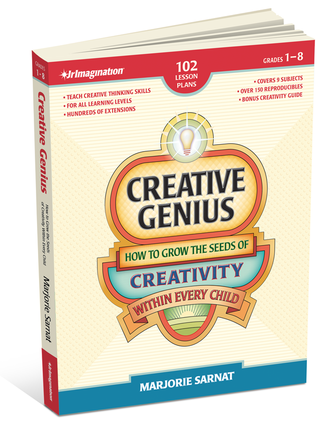100 Years Later the Imagination of John Martin Still Delights
 Sunday, April 14, 2013 at 2:30PM |
Sunday, April 14, 2013 at 2:30PM |  Marjorie Sarnat
Marjorie Sarnat Meet one of my favorite Creative Heroes. Morgan van Roorbach Shepard had a lonely life in the 1870s. He was orphaned at 9 and raised in a series of American boarding schools where he was an outcast. Yet he believed in the power of creativity (whether he knew the word as we mean it or not), and he believed in the potential of children's minds.
Later he renamed himself John Martin, honoring a colony of Martin birds he enjoyed watching as a child, and began writing and illustrating children's stories and verse. In 1908 he founded an imaginative publication called John Martin's Letters, which he mailed to 2000 children each month.
By 1913 the letters had grown into a popular children's magazine, John Martin's Book, which continued through 1933.
 WORDS AND PICTURES – These stylish, whimsical silhouettes with accompanying verses were characteristic of the illustrations in John Martin's Books.
WORDS AND PICTURES – These stylish, whimsical silhouettes with accompanying verses were characteristic of the illustrations in John Martin's Books.
Notable writers and artists, such as Johnny Gruelle (Raggedy Ann Stories) contributed regularly. The illustrations were eye-catching with high contrast and many silhouettes. Artist George Carlson contributed over fifty of the strikingly designed covers along with most of the puzzles and riddles. A wonderfully off-beat character named Peter Puzzlemaker presented the puzzles.
What a thrill it is for me, personally, to hold these vintage publications in my hands and know that some child, 100 years ago, loved them too (and often left their marks in them). Here are some examples from my collection of John Martin's Books, which these many years later still delight. Creativity knows no bounds.
 TO PUZZLE LITTLE PUZZLERS – Here is a cover design for a 1922 book of collected puzzles. The lovable, bespectacled Peter Puzzlemaker appears throughout this publication and most other John Martin's Books.
TO PUZZLE LITTLE PUZZLERS – Here is a cover design for a 1922 book of collected puzzles. The lovable, bespectacled Peter Puzzlemaker appears throughout this publication and most other John Martin's Books.
 INKBLOT CHALLENGE – The Rorschach Inkblot Test was created in 1921 as a diagnostic tool. This illustration was created in the 1920s by John Martin to challenge young readers.
INKBLOT CHALLENGE – The Rorschach Inkblot Test was created in 1921 as a diagnostic tool. This illustration was created in the 1920s by John Martin to challenge young readers.
 RANDOM COMBINATIONS – This bit of fun from the 1920s uses the creative thinking techniques of random combinations such as found on a morph chart. (To learn more about attribute listing and morph charts, see "Creative Genius," pgs. 12, 14, and 15.)
RANDOM COMBINATIONS – This bit of fun from the 1920s uses the creative thinking techniques of random combinations such as found on a morph chart. (To learn more about attribute listing and morph charts, see "Creative Genius," pgs. 12, 14, and 15.)
 BEMUSED – I've found fifty objects starting with the letter 'B' and I'm still looking.
BEMUSED – I've found fifty objects starting with the letter 'B' and I'm still looking.
 DISTINCTIVE STYLE – This George Carlson illustration and verse is just pure fun.
DISTINCTIVE STYLE – This George Carlson illustration and verse is just pure fun.
 BOW-WOW THE DOG – A creative page from John Martin's Letter which was reprinted in a later volume of John Martin's Book.
BOW-WOW THE DOG – A creative page from John Martin's Letter which was reprinted in a later volume of John Martin's Book.
 YOU CAN, TOO – This is a brain twister as well as a tongue twister.
YOU CAN, TOO – This is a brain twister as well as a tongue twister.
 A COVER DESIGN FOR SUMMER – An unlikely dark circle for a sun pulls you into the cheerful illustration. The handling of the water is wonderful to behold. In 1918, 25 cents bought hours of delightful diversions for kids who had no television, Internet, or video games.
A COVER DESIGN FOR SUMMER – An unlikely dark circle for a sun pulls you into the cheerful illustration. The handling of the water is wonderful to behold. In 1918, 25 cents bought hours of delightful diversions for kids who had no television, Internet, or video games.
 A VALENTINE'S DAY COVER – By 1923, inflation had boosted the price of the magazine to a whopping 40 cents — still an amazing value for hours of challenging puzzles, games, creative stories, and beautiful artistry.
A VALENTINE'S DAY COVER – By 1923, inflation had boosted the price of the magazine to a whopping 40 cents — still an amazing value for hours of challenging puzzles, games, creative stories, and beautiful artistry.
 THE ARMADILLO – Here is another example of a masterful illustration with a fun poem.
THE ARMADILLO – Here is another example of a masterful illustration with a fun poem.
I hope you enjoy these. Click on any one of the images to see a larger size suitable for printing. If you'd like to see more, let me know in the comments.
The John Martin images on this post have all been restored and enhanced through careful image editing. They are © 2013 Jr Imagination and can be used under this Creative Commons license:

John Martin's Book restored illustrations by Jr Imagination is licensed under a Creative Commons Attribution-NonCommercial-NoDerivs 3.0 Unported License.
Share the images with your children for personal or classroom use, post them on Pinterest or other social networks. In the future we may publish a curated edition of these works (we have thousands of pages in our collection). We also have plans to dedicate a place on our site for these and similar works.



